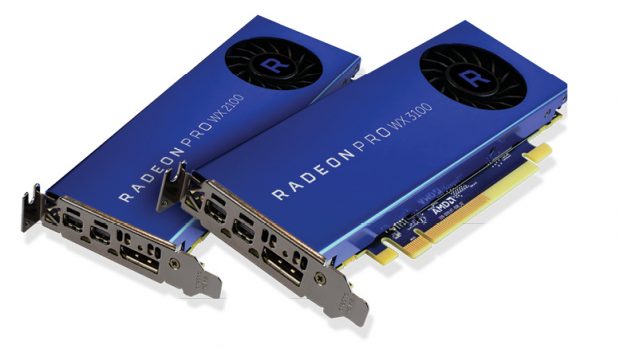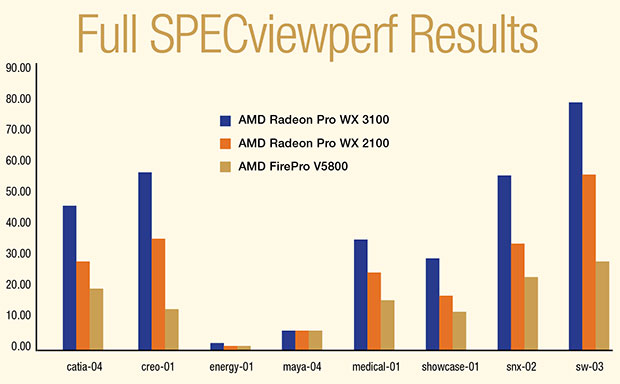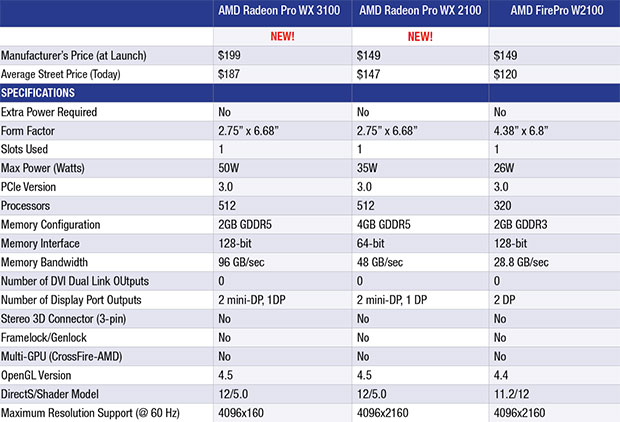AMD’s Very Fast Entry-Level GPUs

The Radeon Pro WX 2100 and WX 3100 entry-level workstation graphics cards are said to have performance improvements of up to 2X over the company’s previous generation AMD FirePro products, AMD reports.
August 1, 2017
On June 1, AMD filled out the rest of its new Radeon Pro WX workstation graphics card lineup with the introduction of the Radeon Pro WX 2100 and WX 3100. Billed as the “fastest entry-level workstation graphics cards,” AMD claims performance improvements of up to 2X over its previous generation AMD FirePro products. The Sunnyvale, CA-based company also stated that its new boards outperformed its competition—the NVIDIA Quadro P400 and P600—by as much as 20% and 28%, respectively, in its own internal evaluations.
Because we had already tested the new AMD Radeon Pro WX 5100 when it was introduced earlier this year (see AMD Radeon Pro Review: A New Name and a New Look), we were anxious to get our hands on the new WX 2100 and WX 3100 as well so that we could put them to the test.
 The Radeon Pro WX 2100 and WX 3100 entry-level workstation graphics cards are said to have performance improvements of up to 2X over the company’s previous generation AMD FirePro products, AMD reports.
The Radeon Pro WX 2100 and WX 3100 entry-level workstation graphics cards are said to have performance improvements of up to 2X over the company’s previous generation AMD FirePro products, AMD reports.Nearly Identical, Except for Memory
The Radeon Pro WX 2100 and WX 3100 are based on the same fourth-generation Graphic Core Next (GCN) 14nm architecture. Both also support AMD’s power monitoring and management technologies. AMD PowerTune dynamically optimizes GPU power usage and AMD ZeroCore Power technology significantly reduces power consumption when idle.
The two new boards are quite similar inside and out. Externally, they are nearly identical. Both are single-slot, low-profile boards, measuring just 2.75x6.68 in.—designed to fit into the latest small form factor workstations—with a 4.38-in. bracket to facilitate mounting in a standard workstation. Both boards offer two mini-DisplayPorts and a single DisplayPort 1.4 connection, and come with a minDP-to-DVI SL adapter. The WX 2100 and WX 3100 can each drive up to three 4K displays at 60Hz or one 5K display at 30Hz. In fact, the only way to visually tell them apart is by the model number emblazoned on the side of the metallic blue fan housing.
 SPECviewperf performance of the new WX 2100 and WX 3100 compared with an older-generation AMD FirePro board.
SPECviewperf performance of the new WX 2100 and WX 3100 compared with an older-generation AMD FirePro board.Internally, both boards use the same Polaris GPU, with eight compute units, for a total of 512 stream processors. The GPUs in both boards run at a peak clock rate of 1219MHz to deliver performance of up to 1.25 TFLOPS (single-precision). And both boards provide native support for 10-bits per color channel, for an effective 30-bits per pixel. In fact, the only significant internal difference is the memory configuration.
With an MSRP of $149, the AMD Radeon Pro WX 2100 comes with 2GB of GDDR5 memory on a 64-bit interface. This enables the WX 2100 to deliver a maximum memory bandwidth of 48GB/second. Although its predecessor—the FirePro W2100 (hosting five compute units for a total of 320 stream processors)—used a 128-bit memory interface, it achieved a maximum memory bandwidth of 28.8 GB/second, while consuming just 26 watts. At 35 watts, the Radeon Pro WX 2100 is still frugal but does use a bit more power.
At $199, the AMD Radeon Pro WX 3100 comes with 4GB of GDDR5 memory on a 128-bit interface. Although it runs its memory at the same 1500MHz clock rate and 6Gb/second memory data rate as the WX 2100, the WX 3100 achieves a maximum memory bandwidth of 96GB/second. Power consumption for the WX 3100 is also quite low—just 50 watts.
Testing the New Boards
Because AMD sent us both boards, we were able to perform our own tests. We ran version 12 of the SPECviewperf benchmark (spec.org) using the same workstation as in our previous reviews of the new AMD and NVIDIA GPUs—a BOXX workstation (boxx.com) equipped with an Intel Core i7-6700K quad-core CPU, 16GB of memory and a 1TB PCIe SSD, running the latest version of Windows 10 Pro 64-bit (see NVIDIA Quadro Review: Super Computer Graphics).
Specifications: Old vs. New
 Specifications for the new AMD Radeon Pro-series graphics boards compared with the previous generation AMD
Specifications for the new AMD Radeon Pro-series graphics boards compared with the previous generation AMDFirePro W-series.
We typically compare new graphics cards to the previous generation by testing the new boards and older boards in the same workstation—using the latest certified video driver—so that the only variable is the GPU itself. But, since we never had the opportunity to test the previous generation of AMD graphics boards, we could not make that comparison. We also did not have samples of the NVIDIA Quadro P400 or P600, so we were unable to verify AMD’s claims.
But we did include results for an even older, midrange AMD FirePro V5800. The performance improvement over that board was quite dramatic. Although the difference compared with more recent boards would not be as great, the similarities of our results to those published by AMD lead us to believe AMD’s claimed performance improvement.
Like previous AMD boards, all the new Radeon Pro WX series graphics cards are fully certified with most CAD and DCC applications. The boards use the new Radeon Pro Software Enterprise Driver, which is different from the unified video drivers used by older FirePro cards. AMD promises regular updates to that driver on the fourth Thursday of each quarter. The new driver (64-bit only) is available for Windows 7, Windows 10 and Linux.
The new Radeon Pro boards come with 24/7 VIP customer support, a three-year limited warranty and an optional free seven-year extended limited warranty upon product and customer registration. AMD has mounted a serious challenge to NVIDIA. Game on.
More Info:
Subscribe to our FREE magazine, FREE email newsletters or both!
About the Author
David Cohn is a consultant and technical writer based in Bellingham, WA, and has been benchmarking PCs since 1984. He is a Contributing Editor to Digital Engineering, the former senior content manager at 4D Technologies, and the author of more than a dozen books. Email at [email protected] or visit his website at www.dscohn.com.
Follow DE





